Posts: 3
Threads: 1
Joined: Jul 2025
Reputation:
0
06-07-2025, 04:12 PM
(This post was last modified: 06-07-2025, 04:18 PM by alpha.
Edit Reason: Added a 3d render from school project
)
Hello everyone,
Not sure if this is where I should post this, but I'm trying to identify the exact model of some automatic swing gate operators at my school. I suspect they are BFT Lux hydraulic models, but I'm not 100% sure, especially given some visual differences from current models.
Here's what I know and observe:- Manufacturer: The flasher is BFT, and the beam sensor is Beninca.
- Type: They are definitely hydraulic linear operators. I can hear a distinctive "shh" sound when they slow down, confirming they're hydraulic and not electromechanical.
- Movement:
- When an open command is given, the motors briefly run in the closing direction for about a second, then they start opening.
- The left gate opens first, followed by the right gate after a 1.5-second delay.
- The opening movement is not entirely smooth; it can be a bit jerky/bumpy.
- Design:
- They are quite long in design, consistent with robust swing gate operators.
- As you can see in the photo, they have a distinctive three-section design. The main body, a central black cap/ring (which hides the manual release allen key port), and then the rear mounting section. This black cap acts as a clear visual separator between the two larger sections.
- While they resemble BFT Lux models, the specific appearance of the "grey parts" and the distinct sectional design doesn't perfectly match all current Lux images I've found online, leading me to believe they might be an older generation. I'm wondering if they could be an older BFT Lux FC model specifically.
- Manual Release Confirmation: I've personally seen maintenance staff access that central black cap to use an allen key. They did this when one of the gates was ajar (open a tad) to put it into manual release mode, allowing them to move it by hand and then "reset" the system. This confirms the presence of a manual release and likely a hydraulic lock.
Photo: The exact same “mystery model” I found at a tram depot on google maps, so here’s a image:
 More Info:
- Flasher sequence: Slow flashing when opening, steady when open, fast flashing when closing.
- The gates seem to only open to about 80 degrees.
My Questions:
More Info:
- Flasher sequence: Slow flashing when opening, steady when open, fast flashing when closing.
- The gates seem to only open to about 80 degrees.
My Questions:
- Can anyone help me confirm the exact model or generation of these operators from the photo and description? Does the "three-section" design with the central black cap ring a bell for a particular Lux variant or older model?
- What’s the best way to get service for these gates? The one on the left is sometimes open slightly when I look at it (I don’t know the cause). Also, a magnetic lock is fitted, but the motor doesn’t push the gate far enough for it to automatically engage.
- Is the brief reverse movement at the start of the opening cycle a normal characteristic for BFT hydraulic operators like this?
Any insights or advice would be greatly appreciated!
Thanks in advance for your help.
Oh and here is a 3D render of what the gates look like. I made this for a school project:
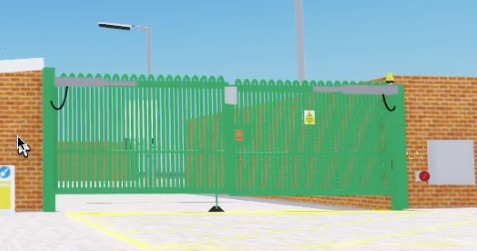
Posts: 5
Threads: 0
Joined: Jul 2025
Reputation:
0
Really need a better picture of the ram.
Reverse movement is classed as reverse stroke to release electric locks or sprung drop bolts before opening gates, totally normal but not always needed.
General service agreement/contract should already be active if youe school is using the gates. BFT brackets tend to bend on the leaf reducing their final travel to the maglock, these will require replacing. Sounds like the stroke geometry has not been correctly adhered too.
BFT Lux's are a standard model and haven't really changed, the 230v motor relies on a 6.3uf capacitor to offset the phase and drive the motor clockwise or anticlockwise depending on which winding is energised. They do not have a slowdown phase but a hydraulic restictor valve setup. You can use the slowdown parameter on different boards i.e. FAAC 455, SEA Gate2/swing etc... BFT Rigel 4/5 or 6 specifically state not to use the slowdown parameter for hydraulic motors due to the stall effect.
Hope this helps
Darren
Posts: 3
Threads: 1
Joined: Jul 2025
Reputation:
0
(08-07-2025, 09:54 AM)old guy Wrote: Really need a better picture of the ram.
Reverse movement is classed as reverse stroke to release electric locks or sprung drop bolts before opening gates, totally normal but not always needed.
General service agreement/contract should already be active if youe school is using the gates. BFT brackets tend to bend on the leaf reducing their final travel to the maglock, these will require replacing. Sounds like the stroke geometry has not been correctly adhered too.
BFT Lux's are a standard model and haven't really changed, the 230v motor relies on a 6.3uf capacitor to offset the phase and drive the motor clockwise or anticlockwise depending on which winding is energised. They do not have a slowdown phase but a hydraulic restictor valve setup. You can use the slowdown parameter on different boards i.e. FAAC 455, SEA Gate2/swing etc... BFT Rigel 4/5 or 6 specifically state not to use the slowdown parameter for hydraulic motors due to the stall effect.
Hope this helps
Darren
{{Follow-up Reply}} Disclaimer: This post was generated with the assistance of computer intelligence.
Hi Darren,
Thank you so much for this incredibly detailed and helpful reply! It clarifies a lot and gives us some very strong leads.
Regarding the picture of the ram, I understand. As mentioned, my access is limited to publicly available Street View, but I've tried to provide the best close-up I could get from that source (the image you'll see titled "image_5225e5.png"). If there are any other specific angles or aspects you think might still be discernible from such images, please let me know.
Your explanation of the reverse stroke to release electric locks makes perfect sense and clarifies that behavior for us – thank you for that!
We'll definitely look into the service agreement aspect.
Your insight about BFT brackets tending to bend on the leaf, reducing their final travel to the maglock, is absolutely invaluable. This sounds exactly like what we're observing with the problematic South End gates not fully engaging the magnetic lock and needing a shove. This strongly suggests they are indeed BFT Lux motors, which is a massive step towards identification. We will investigate the brackets and stroke geometry as a primary cause.
Now, regarding your point about BFT Lux not having a slowdown phase and instead relying on a hydraulic restrictor valve setup, this is a very important detail that I wanted to clarify my observation on:
On the problematic South End gates, the "damped harmonic motion" (the oscillation/bouncing) occurs specifically when the gates are decelerating towards their end stops (both open and closed). My previous observation that the identical North End gates (and those at The Woodlands) "open slower and seem quite smooth" led me to believe this was a form of controlled slowdown.
Given this, could the "damped harmonic motion" I'm seeing on the problematic South End gates be a malfunction of this hydraulic restrictor system, perhaps exacerbated by the history of mechanical issues (piston popping out, pushed-up end section)? Or, if the other identical units genuinely exhibit a smooth, controlled slowdown, could that imply they are paired with a different control board (like a FAAC 455 or SEA Gate2/swing, as you mentioned), despite using the BFT Lux motor?
Your insights on the Rigel boards not recommending slowdown for hydraulic motors are also very useful for understanding the system's design constraints.
Again, thank you so much for taking the time to provide such a comprehensive and targeted response. This is extremely helpful!
I'm trying to identify the exact model and manufacturer of some automatic swing gate operators at a school, and seeking advice on their operation. While the beam sensors are Beninca and the flasher on the problematic South End gates is BFT, I'm now unsure if the motors themselves are BFT, despite their appearance, as I've found another model that looks very similar.
Important Note on Orientation: Throughout this post, "left" and "right" refer to the gates when looking from the side where they open outwards (the non-motor side).
Visual Aids & Context
To better understand the layout of the school and the gate locations, please refer to the site diagram below. Following that, I've included multiple photos of the identical North End gates. Please note, these photos are taken from publicly available Street View, which explains any blurriness or limited angles, as I do not have permission to photograph the problematic South End gates directly. However, the motor design is exactly the same on both pairs.
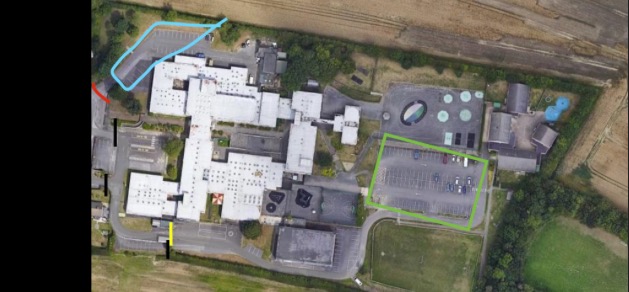 Diagram Key:
Diagram Key:- Green Box: Carpark 1 (protected by South End Gates)
- Blue Box: Carpark 3 (protected by North End Gates)
- Red Line: North End Gates
- Yellow Line: South End Gates

- North End Gates (wider view from public side), showing a pedestrian gate to the right.
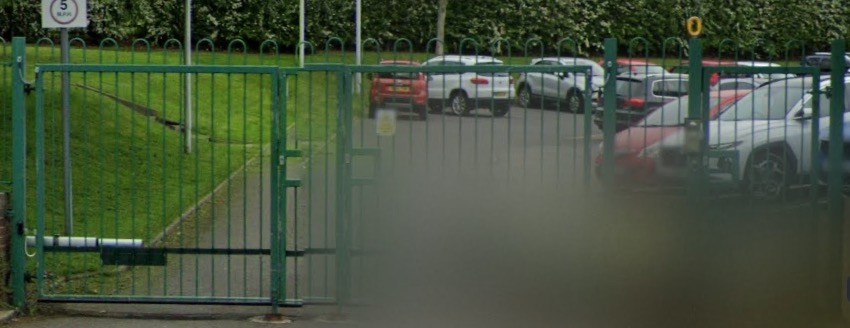
- North End Gates (slightly closer, blurry and glitchy view from public side).
-
 Close-up of one of the identical motors (from the North End gates).
Close-up of one of the identical motors (from the North End gates).
Shared Features & System Integration (Both School Gate Pairs)
- Gate Purpose: The South End gates (Yellow line on diagram) protect a taxi drop-off and pick-up area and Staff Car Park 1 (Green box on diagram). The North End gates (Red line on diagram) protect Staff Car Park 3 (Blue box on diagram).
- Magnetic Locks: Both the north and south end gates at the school have magnetic locks to secure them in the closed position.
- Control Box: Both sets of gates use the same style of grey, metal, boxy control box, featuring a simple twist lock mechanism.
- Internal Control Box Observations: I noticed a “timer” or “clock” thing with what I think was the current time. There’s also another device (which I faintly remember having a few light indicators on and a “reset” button to open the gates and a translucent dark blue design).
- Gewiss GW70437 Isolator: A master Gewiss isolator switch controls the power for both sets of gates. Activating this isolator not only disables the gates themselves but also turns off the associated ID and intercom systems throughout the school. For the south gates, it specifically disables the manual, magnetically-locked pedestrian gate as well.
- Intercom System: Both gates are integrated with an intercom system. For the south end gates, the operator at reception uses a telephone system where pressing "3" on the phone opens the gates. A notable operational detail is that a 1-second tone is heard when the call ends, just before the gate begins to open.
- Impro Card Scanner: Access to both gate areas is managed by Impro card scanners, which are consistent with other access points around the school.
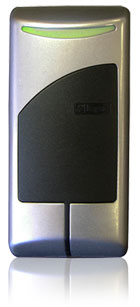
- North End Gate Specific Detail: There is a green button located next to the control box on the other side (non-public side) of the north end gates. Its function (e.g., opens main gates, unlocks pedestrian gate) is unknown.
Observations on the Problematic South End Gates
- Type: They are definitely hydraulic linear operators. I can hear a distinctive "shh" sound when they slow down, confirming they're hydraulic and not electromechanical.
- Motor Model's Installation Era & Widespread Use (Inference):
- I have Street View photos of this identical motor model on gates at the school's north end, which were installed sometime between July 2009 and July 2016. I assume the south end gates were installed around the same time.
- I've also found two more identical pairs of this motor model installed at a nearby housing complex called The Woodlands in Bolton-upon-Dearne, which was completed around 2019. These gates at The Woodlands also appear to function correctly when I drive past them.
- This suggests the motor model has had a long production run or continued popularity well into the 2010s.
- Comparison to Identical, Functional Gates: The identical pairs at the school's north end and at The Woodlands in Bolton-upon-Dearne both open slower and seem quite smooth, and they function correctly. This makes me confident that the issues on the problematic South End gates are malfunctions, not normal operation for this model.
- Physical Damage / Condition (Key Observation on the problematic South End gates):
- One time, the piston rod ("track thing") on one of the gates actually popped out of its connection to the gate, rendering it unusable until reattached.
- For some time after that incident, the end section of that operator was visibly pushed up, and its plastic end cap is missing. Although the end section appears to be back down now, the missing cap persists.
- Movement (the problematic South End gates - Detailed "Jerky" Clarification):
- When an open command is given, the motors briefly run in the closing direction for about a second, then they start opening.
- The left gate opens first, followed by the right gate after a 1.5-second delay.
- The opening movement is not entirely smooth. Both when starting to move and especially when slowing down at the end of their travel, the gates exhibit damped harmonic motion (a noticeable oscillation or "bouncing" before stopping), rather than decelerating smoothly. (This seems highly likely connected to the history of mechanical issues).
- Crucial Detail: During the initial brief run in the closing position (before opening), the gates exhibit damped harmonic motion/shaking because they don’t operate smoothly. Also, there’s a magnetic lock on the left gate. This magnetic lock frequently fails to engage properly, due to the gate not closing quite enough, necessitating a manual "shove" by staff (e.g., taxi guides). Sometimes this motion is just enough to engage the lock, which then releases as soon as the gates begin to open.
- Also, the magentic lock turns off just after the reverse cycle (when the motor briefly runs in the closing direction on opening).
- Current Operational Malfunctions (on the problematic South End gates):
- Gates Not Fully Closing/Drifting: The south end left gate sometimes becomes a tad ajar due to it not locking properly, even when it should be fully closed. Notably, when the gates are in a partially open or ajar state, I've observed that pressing a "reset" button on the control box causes the gates to open(complete a full open cycle).
- Motor Over-running at End Stops: After the gates have fully opened or fully closed, the motors continue to run for approximately 10 seconds before finally stopping. The maintenance guy indicated this is to keep them open longer, but I believe there's a more efficient way to program this, suggesting a potential underlying issue with limit detection or calibration.
- Beam Sensor Active When Closed: Even when the gates are fully closed and the motors have finally stopped, the beam sensor remains active.
- Design (from observation of all identical pairs):
- They are quite long in design, consistent with robust swing gate operators.
- As seen in the provided photos, they have a distinctive three-section design. The main body, a central black cap/ring (which hides the manual release allen key port), and then the rear mounting section. This black cap acts as a clear visual separator between the two larger sections.
- I've personally seen maintenance staff access that central black cap to use an allen key. They did this when one of the gates was ajar (open a tad) to put it into manual release mode, allowing them to move it by hand and then "reset" the system. This confirms the presence of a manual release and likely a hydraulic lock.
- Accessories: The beam sensor is Beninca on both sets of gates. The flashing light on the problematic South End gates is a BFT RADIUS (R0 model). The identical gates at the north end have a Beninca IRI.LAMP.Y flashing LED light (24 / 230 Vac/dc).
- Flasher Malfunction (on the problematic South End gates - Diagnosis Confirmed):
- The BFT RADIUS flasher is now on all the time, even when the gates are completely closed and stationary. It has completely stopped flashing. This is definitively a controller issue, as when power is returned to the system, the light now turns on instantly, unlike the usual 1-second delay seen in normal operation.
My Questions:
- Can anyone help identify the manufacturer and exact model/generation of these gate operators from the provided photos and detailed description? Given their widespread presence and consistent visual features across different installations (including new builds up to 2019), I'm considering either older BFT Lux models or FAAC S450s as strong possibilities, as they look remarkably similar to my observations.
- My main concern is the "damped harmonic motion" observed both at the start of movement and especially during slowdown at the end of travel, especially since identical units elsewhere operate smoothly and slower. Considering the history of the piston rod popped out and the end section being pushed up, what are the most likely causes for this abnormal oscillation? Does this severe mechanical history suggest internal damage to the operator's damping mechanisms, issues with the gate's hinges/structure, or mounting failures?
- Regarding the left gate's magnetic lock failing to engage properly (often traveling too far, requiring a manual shove), and the gates frequently becoming a tad ajar (requiring a "reset" button press on the control box to get them to open): What could cause this behavior? Is it related to magnetic lock misalignment/fault, limit switch/encoder faults, control panel malfunction, or something else that prevents a proper "closed" state?
- Is the brief reverse movement at the start of the opening cycle a normal characteristic for any hydraulic operators like this (e.g., BFT, FAAC, etc.), or does it indicate an issue specific to certain brands/models? (It seems related to the magnetic lock in my case).
- Regarding the motors over-running by 10 seconds at both fully open and fully closed positions (despite a maintenance explanation that seems inefficient), and the beam sensor remaining active when the gates are fully closed: What are the likely causes for these behaviors? Do they point to faulty limit switches, issues with motor encoders, incorrect control panel programming (e.g., excessively long run times), or a control board malfunction?
- Regarding the BFT RADIUS R0 flasher being constantly on and having stopped flashing, now turning on instantly after power cycle (indicating a likely controller issue): What are the probable causes for this? Could it be a faulty relay on the control panel, a wiring issue, or something else entirely? (I assume the control panel is of the same brand as the motors, if that helps in diagnosis).
Any insights or advice would be greatly appreciated! Then, I can learn more about them and assist with repairs.
Thanks in advance for your help.
Posts: 3
Threads: 1
Joined: Jul 2025
Reputation:
0
And here’s a photo of the BFT R0 flasher if it helps:
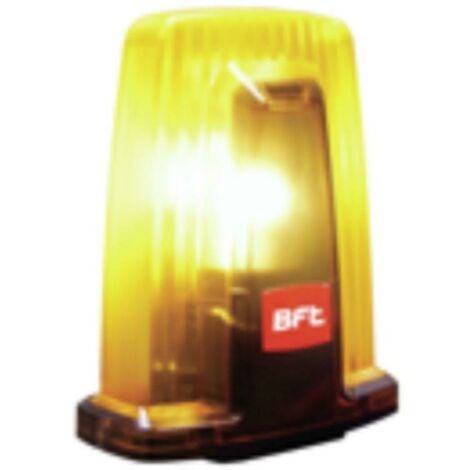
Posts: 29
Threads: 0
Joined: Apr 2024
Reputation:
0
(06-07-2025, 04:12 PM)alpha Wrote: Hello everyone,
Not sure if this is where I should post this, but I'm trying to identify the exact model of some automatic swing gate operators at my school. I suspect they are BFT Lux hydraulic models, but I'm not 100% sure, especially given some visual differences from current models.
Here's what I know and observe:- Manufacturer: The flasher is BFT, and the beam sensor is Beninca.
- Type: They are definitely hydraulic linear operators. I can hear a distinctive "shh" sound when they slow down, confirming they're hydraulic and not electromechanical.
- Movement:
- When an open command is given, the motors briefly run in the closing direction for about a second, then they start opening.
- The left gate opens first, followed by the right gate after a 1.5-second delay.
- The opening movement is not entirely smooth; it can be a bit jerky/bumpy.
- Design:
- They are quite long in design, consistent with robust swing gate operators.
- As you can see in the photo, they have a distinctive three-section design. The main body, a central black cap/ring (which hides the manual release allen key port), and then the rear mounting section. This black cap acts as a clear visual separator between the two larger sections.
- While they resemble BFT Lux models, the specific appearance of the "grey parts" and the distinct sectional design doesn't perfectly match all current Lux images I've found online, leading me to believe they might be an older generation. I'm wondering if they could be an older BFT Lux FC model specifically.
- Manual Release Confirmation: I've personally seen maintenance staff access that central black cap to use an allen key. They did this when one of the gates was ajar (open a tad) to put it into manual release mode, allowing them to move it by hand and then "reset" the system. This confirms the presence of a manual release and likely a hydraulic lock.
Photo: The exact same “mystery model” I found at a tram depot on google maps, so here’s a image:
More Info:
- Flasher sequence: Slow flashing when opening, steady when open, fast flashing when closing.
- The gates seem to only open to about 80 degrees.
My Questions:
- Can anyone help me confirm the exact model or generation of these operators from the photo and description? Does the "three-section" design with the central black cap ring a bell for a particular Lux variant or older model?
- What’s the best way to get service for these gates? The one on the left is sometimes open slightly when I look at it (I don’t know the cause). Also, a magnetic lock is fitted, but the motor doesn’t push the gate far enough for it to automatically engage.
- Is the brief reverse movement at the start of the opening cycle a normal characteristic for BFT hydraulic operators like this?
Any insights or advice would be greatly appreciated!
Thanks in advance for your help.
Oh and here is a 3D render of what the gates look like. I made this for a school project: Hi,
From the look of the photos, and the motors having three sections to the body, they could be a type of BFT Kustos although without a closer image I wouldn't be able to make a judgement on an exact model.
If the motor is not quite reaching the maglock then I would recommend increasing the force of the motor and then putting it through a position learn.
The reversing before the opening command could be down to the "ram" function on BFT operators it is typically activated when a maglock or electric lock is in use so the gates do not jam on the lock, however this can be turned off.
I hope this is of some help, if you have any questions please let me know.
Posts: 1
Threads: 0
Joined: Nov 2025
Reputation:
0
Hi there, I lost the keys to my old accounts, so it's me again. Anyways, I have some awesome bits of info and some hi-res photos to share of the South gates – and a video!
What I've learned:
– The end of the body can be removed to expose the mechanism (and the gates can run without these covers, albeit looking quite ugly)
– The south end gates have had to be fixed almost every day (a few times, one of the openers looked like it had collapsed and the gate was open far wider than normal with a traffic cone in front of it)
– Also, the problem with the left gate not going far enough for the maglock to engage has been fixed... with a block of wood on the maglock, so now they "slam" together.
View the video (sorry if the quality is trash): https://drive.google.com/file/d/1sfLCF7Y...sp=sharing
Photo:
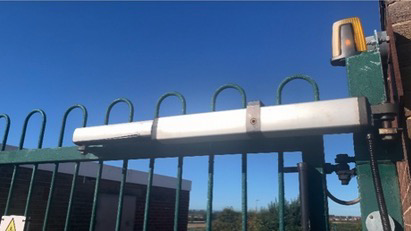
You can see the BFT R0 flasher too, which is STILL not working properly.
|






